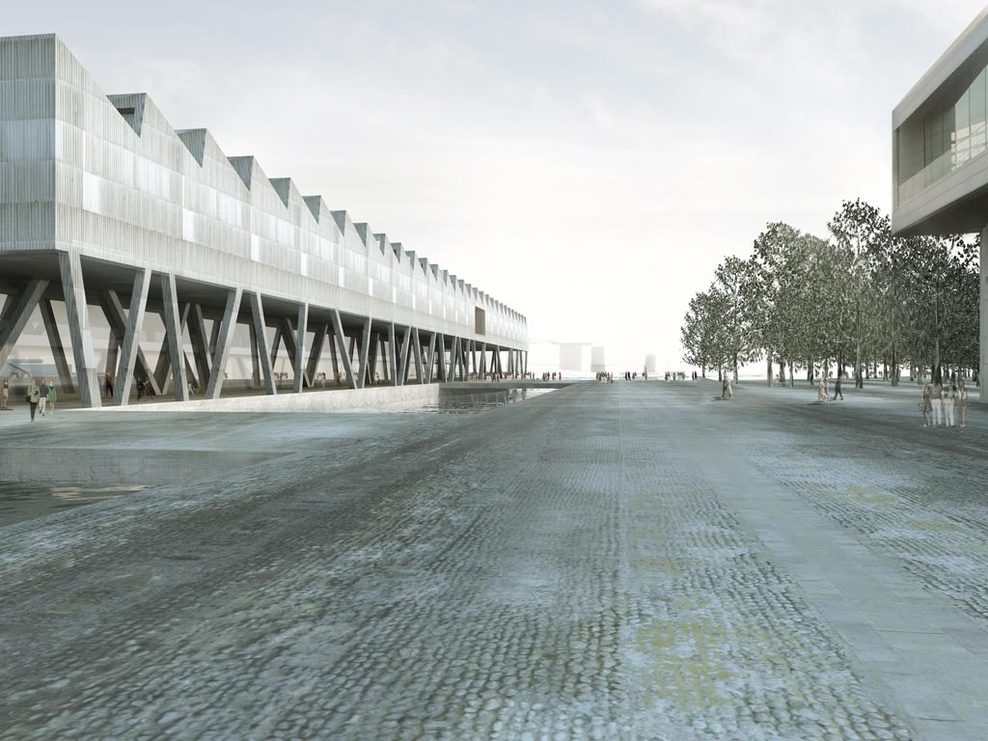Christ & Gantenbein Architects . Lie Øyen Arkitekter
A new museum for the Munch and Stenersen Collections is emerging at the Akerselvas’s estuary.
Oslo turns a new face to the fjord
The existing situation is transformed into a new cultural forum on the docks: the opera, the museum and the park in the middle bring the city to the fjord, like three fingers reaching for the infinite landscape. The Munch Museum nestles up on the eastern shore of the Akerselva, opposite the park. Together they form the mouth of the river into the fjord and build the end of the Akerselva Common. The latter is like a long square, an urban space, in which the Akerselva flows, sometimes still contained by the historic conserved wall. A bridge from the park to the entrance of the museum transforms the natural estuary situation into a highly urban scene, a part of the promenade along the shore. Couldn’t the „Girls on the bridge” from Munch have been standing here?
Over the opera, through the park, under the museum
The museum is an inviting open space, orientated towards the city, the water and the park. The new museum offers a continuation of the enchanting promenade across the opera’s roof, regularly punctuated with leisure facilities and which leads further along the shore of Bjørvika. One experiences a sequence of spaces which leads from the city over the opera, through the park until its tip which reaches into the fjord, along the museum’s diaphanous arcades where the water reflects on the slabs, onward along the sea bank up to Bjørvika. Art and leisure happen in the same place and invite even outstanding events like an open-air exhibition from the Munch museum in the park or an open-air painting course under the trees.
Like a harbour dock reconquered by nature, the park floats like a wild peninsula in the fjord, just between the opera and the museum. It is planted with a cultivated nature, like the parks of the 19th century: loose tree rows respond to the tilted pillars of the museum, emphasize the length of the park and stage the beautiful view into the fjord. Its features offer many leisure possibilities: hard covering for roller skating and grass to lay down on, water basins for small children to splash about in, big steps for sitting and a wide ramp reaching into the water for adventure.
A contemporary art space for Munch
The museum’s architecture for the Munch and Stenersen Collections is straightforward, elegant and functional. The museum reminds one of past harbour architectures of the Akerselva’s estuary in Bjørvika, with its long volume,pillars arranged in a row and a shed roof. It is not a monument, and certainly not a Munch-mausoleum, it is much rather related to the idea of Munch’s own atelier in Åsgårdstrand: It is raised above the ground as if to let the water flow between its pillars. Still its strong presence sets a functional house in a magnificent setting.
The simple architecture, which is slightly withdrawn into itself, provides a contemporary infrastructure for vital exhibitions, for an appreciation of art which is as radical and creative as Munch’s.
The platform features clear, functional and flexible spaces. The project’s flexibility relies on the structural concept of the building. The exhibition floor provides five long partition walls, which function as beams and therefore allow a completely open space on the ground floor, as well as spanning over the area of the underwater tunnel. This spatial structure can be either opened and provide long gallery spaces, or closed with cross partitions to form traditional cabinets. Thanks to the different widths of the spatial layers from 6m up to 15m, surfaces of 16m2 up to 500m2 are resulting from 2,25:1 up to 1:2.25 proportions. The building hence provides proven appropriate space geometry, but can still be open to experimental exhibitions without having to build more partitions. The floor height of 5.80m enables a flexible installation in three dimensions and allows Munch’s monumental work to fully exploit the different spaces. Shed windows allow light into most of the spaces, whereby a modern light steering guarantees an optimal daylight use, the coordination of natural and artificial lighting as well as full compliance with the rigorous art conservation conditions. Nevertheless, the generous floor height allows the installation of a luminous ceiling.
The internal organisation reflects the simplicity of the volume. The art is at the top on one story only, guarded in an „art-box”, carried by tilted pillars, the public functions in the ground floor, and the workshops and administration offices are on the mezzanine floor.
A developing area
While the museum and the park reach to the fjord, the blocks B1 and B4 are anchored in the city structure. They are set orthogonally to the the Dronning Eufemias gate and draw calm and composed urban spaces along the Akerselva River thanks to their compact form. The north block is pre-destined to be an office building due to its setting and proportions. It will provide shopping facilities on the ground floor and first floor and housing on the two top floors. The south block is to be a hotel which primarily welcomes cultural tourism attracted by the museum and the opera.
Emanuel Christ, Christoph Gantenbein, Julia Tobler, Mariana Alves, Anna Flückiger, Josiane Imhof, Cloé Gattigo, Tabea Lachenmann, Annina Meier, Annette Schick, Kai Timmermann, Cristina Trofin Tanja Lie, Kristoffer Øyen, Eivind Øyen, Tai Grung, Elisa Grindland
Structural Engineers:
Conzett, Bronzini & Gartmann, Chur, Switzerland
Landscape Architects:
Müller Illien Landschaftsarchitekten GmbH, Zurich, Switzerland
Services Engineers:
PGMM Schweiz AG, Winterthur, Switzerland
Electrical Engineers:
Herzog Kull Group, Basel
Building Physics and Acoustics:
BAKUS Bauphysik & Akustik GmbH, Zurich, Switzerland
Lighting Engineers:br> Licht Kunst Licht, Bonn, Germany
Museum Advisors:
Adam Szymczyk, Director Kunsthalle Basel
Multiconsult:
Geotechnology: Yngvar Hanson
Fire: Ari Soilammi
Traffic: Jan Orsteen
Security: Tom Thorkaas
Energy, Sustainability: KanEnergi AS, Fritjof Salvesen

.jpg)
.jpg)
.jpg)
.jpg)
.jpg)
.jpg)
